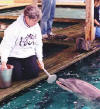Which Animal Has Been Trained Using A Form Of Stimulus Control Known As Targeting?
| Stimulus Control | |
| Learning Activities | |
| 1. Definitions two. Place concepts from video clips (Refer to Clucking Calculator.) 3. Provide your own examples 4. Crossword puzzle five. Word search | |
| Click on the thumbnail to overstate. | Discrimination Training |
| | Bigotry training involves reinforcing a behavior (e.thou., pecking) in the presence of one stimulus but non others. In the moving picture to the left, 1 of the Bailey�s chickens was presented with two note cards; one card contained a red circle, while the other card contained a blue circumvolve. A peck on the red circle was reinforced, while a peck on the blue circle was not reinforced (this process involves differential reinforcement). Eventually, the chicken only pecked the ruddy circle. The Baileys also used note cards with different shapes (e.g., circles v. squares) to demonstrate discrimination grooming involving geometric figures. With discrimination training, animals like chickens are said, in everyday language, to exist able to "tell the difference" between shapes (like circles or squares) or colors (like red or blue), every bit long as the animate being has the appropriate sensory appliance, similar color vision. |
| Click on the thumbnail to overstate. | Discriminative Stimulus (and Generalization) |
| | The discriminative stimulus is the cue (stimulus) that is present when the behavior is reinforced. The animal learns to exhibit the behavior in the presence of the discriminative stimulus. In the example above, the red circle was the discriminative stimulus (sometimes abbreviated SouthwardD, pronounced "S-Dee".) In the case of note cards with squares and circles, if the Baileys had reinforced pecking a square rather than a circle, the SouthD would take been the square. (To complicate the matter, animate being trainers like to phone call the Due southD the "hot stimulus," because behaving in the presence of that stimulus will become the animal a reinforcer.) Further, the animal does not have to interact with the discriminative stimulus - for example, in the post-card vending chicken, a lite signals the availability of reinforcement, just the chicken does not have to interact with the light and only has to pull a loop. Refer to the picture to the left. The staff of ABE oft used "targets" to help control the beliefs of animals. In many demonstrations, the animals were taught to bear on the target with their noses. These targets were "hot" stimuli and, therefore, discriminative stimuli. In curt, discriminative stimuli occur before the beliefs and are said to control the beliefs (refer back to the three-term contingency). �(Generalization occurs when the beast responds to stimuli that are similar to the SD, merely non exactly the same stimuli that were used in training � for instance, to red circles of slightly different hues, to lines of slightly different lengths, to circles of slightly unlike diameters.) |
| Click on the thumbnail to enlarge. | S-delta |
| | The S-delta (SD) is the stimulus in the presence of which the behavior is non reinforced. At first during bigotry preparation, the beast frequently responds in the presence of stimuli that are similar to the SD. These similar stimuli are South-deltas. Eventually, responding to the South-delta will be extinguished. (Beast trainers call the Southward-delta the "cold stimulus.")� Permit's take the example of pecking a scarlet circle. The trainer makes ii cards, ane with a red circle and i with blueish circumvolve. Pecking the ruby circle is reinforced, but non pecking the blue circle. (At commencement, the chicken might peck both circles, but if pecking is only reinforced in the presence of the red circle, pecking will eventually occur simply in the presence of that circle.) The blue circle would be an South-delta. |
Source: https://www3.uca.edu/iqzoo/Learning%20Principles/lammers/stimulus%20control.htm
Posted by: unknowrandead1995.blogspot.com




0 Response to "Which Animal Has Been Trained Using A Form Of Stimulus Control Known As Targeting?"
Post a Comment